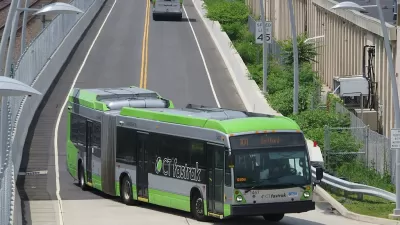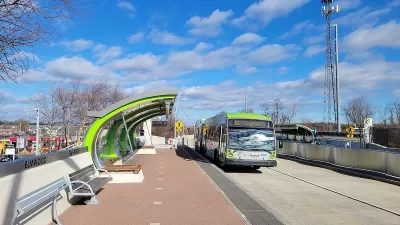The $567 million CTfastrak bus rapid transit system opened for business on March 2, 2015. Since then, the system has provided transit service to a growing number of people.
Scott Whipple reports on the early returns for the CTfastrak bus rapid transit system, which has opened to growing ridership numbers that have exceeded expectations: "More than 150,000 rides have been taken on the CTfastrak Bus Rapid Transit system in the five weeks since operations began on March 2," writes Whipple.
Connecticut DOT officials quoted in the article note that daily ridership on the CTfastrak system currently exceeds 7,000 rides a day. Planners had targeted 11,200 daily rides for both the CTfastrak system and the CTTransit bus routes along the new corridor. Already, combined ridership is over 14,000.
Whipple also sums up the CTfastrak system, for the uninitiated:
"The transit system provides direct service to and from Waterbury, Cheshire, Southington, Bristol, Plainville, New Britain, Newington, West Hartford, Hartford, East Hartford and Manchester. It offers a one-seat, no-transfer ride to many major regional employment, shopping and health care destinationsm as well as connections to the New Haven Line-Waterbury branch rail in Waterbury and Amtrak service in Hartford. A new 4.5 mile multi-use trail now parallels the bus-only roadway from New Britain to Newington Junction."
A system map is also available online.
In a separate article, Don Stacom reports on the popularity of the late-night BRT service serving the university town of New Britain, Connecticut as part of the newly launched CTfastrak system.
"Since CTfastrak started running at the end of March, Central Connecticut State University students have embraced it as a safe, low-cost ride home on Thursday nights. For $1.50, they ride from East Street — near dorms and many off-campus apartments — to the cluster of clubs just a block or two from Union Station [in Hartford]."
Stacom describes the scene on the bus when the late-night service is in effect as well as making the case for the kind of revelry that is permitted on the bus.
FULL STORY: CTfastrak ridership still climbing

Planetizen Federal Action Tracker
A weekly monitor of how Trump’s orders and actions are impacting planners and planning in America.

Map: Where Senate Republicans Want to Sell Your Public Lands
For public land advocates, the Senate Republicans’ proposal to sell millions of acres of public land in the West is “the biggest fight of their careers.”

Restaurant Patios Were a Pandemic Win — Why Were They so Hard to Keep?
Social distancing requirements and changes in travel patterns prompted cities to pilot new uses for street and sidewalk space. Then it got complicated.

Platform Pilsner: Vancouver Transit Agency Releases... a Beer?
TransLink will receive a portion of every sale of the four-pack.

Toronto Weighs Cheaper Transit, Parking Hikes for Major Events
Special event rates would take effect during large festivals, sports games and concerts to ‘discourage driving, manage congestion and free up space for transit.”

Berlin to Consider Car-Free Zone Larger Than Manhattan
The area bound by the 22-mile Ringbahn would still allow 12 uses of a private automobile per year per person, and several other exemptions.
Urban Design for Planners 1: Software Tools
This six-course series explores essential urban design concepts using open source software and equips planners with the tools they need to participate fully in the urban design process.
Planning for Universal Design
Learn the tools for implementing Universal Design in planning regulations.
Heyer Gruel & Associates PA
JM Goldson LLC
Custer County Colorado
City of Camden Redevelopment Agency
City of Astoria
Transportation Research & Education Center (TREC) at Portland State University
Camden Redevelopment Agency
City of Claremont
Municipality of Princeton (NJ)




























